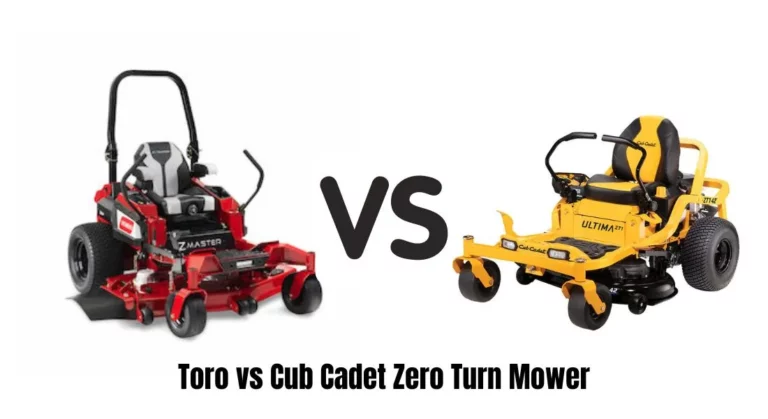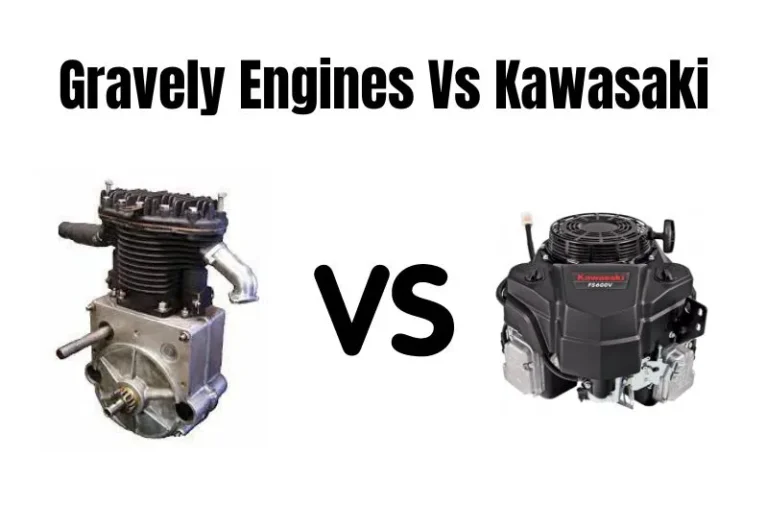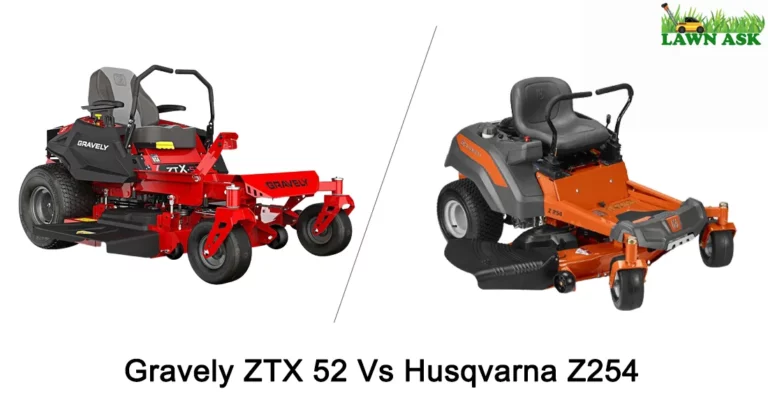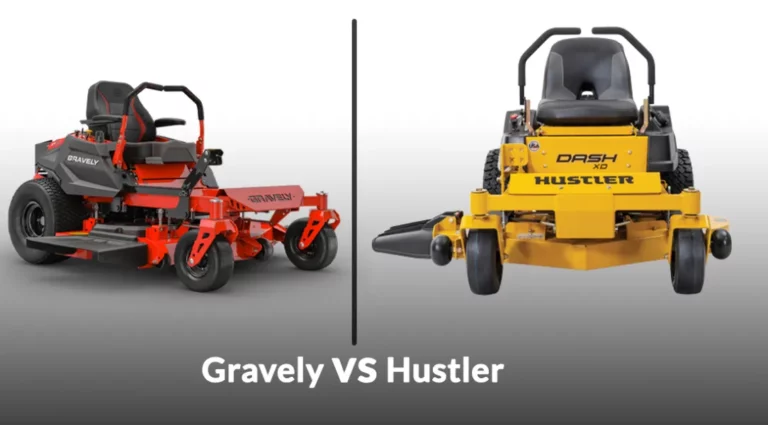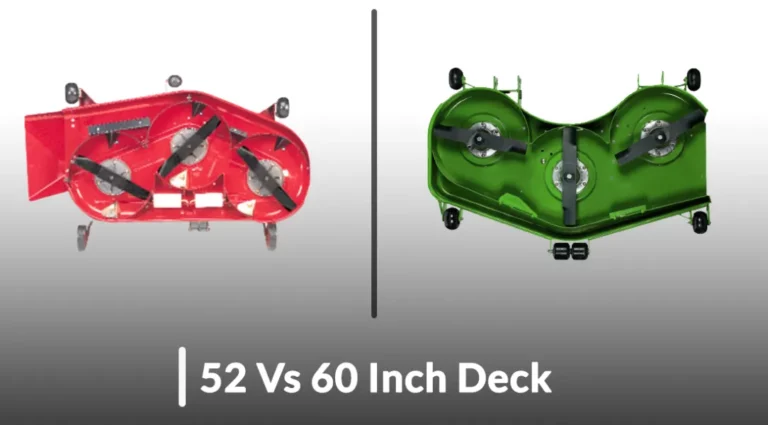2 Blade Vs 3 Blade Mower Deck – What’s the Differences
People are increasingly switching to mower decks with several blades, such as 2 and 3-blades. But do they produce a better cut, or are they worth the extra cost?
Yes, a mower deck with more blades makes more equal cuts, which results in a more appealing lawn. A two or three-blade mower deck improves cutting quality, speed, engine strain, and mulching.
However, both 2-blade and 3-blade mower deck choices have a fair share of pros and cons.
Instead of being perplexed by them, evaluate their differences, benefits, and drawbacks and choose which one is best for you.
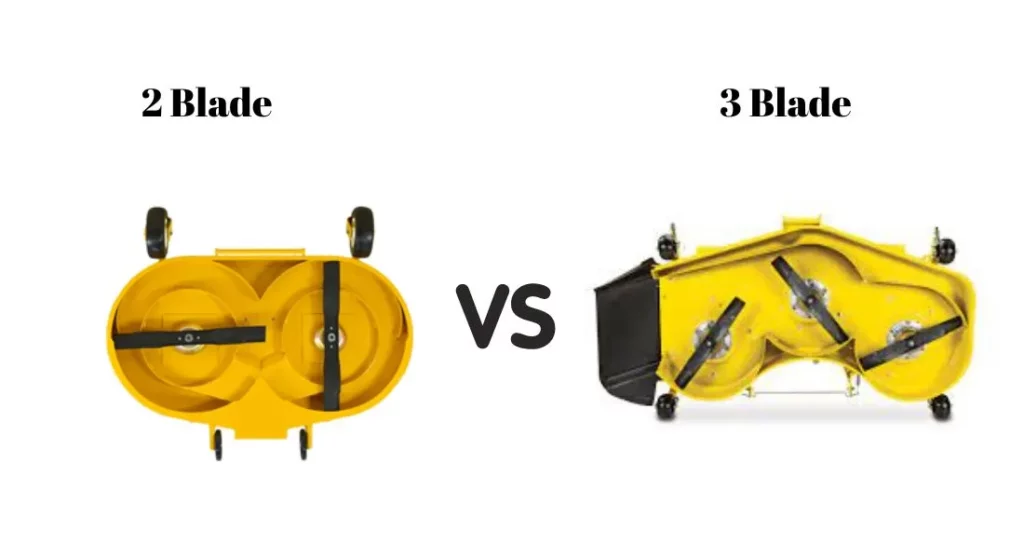
A Quick Comparison 2 Blade Vs 3 Blade Mower Deck:
| Key Aspects | 2 blade deck | 3 Blade deck |
| Weight: | Lighter | Heavier |
| Blade length: | Longer | Shorter |
| Blade material: | Steel or other materials | Steel, carbon, or titanium |
| Cut quality: | May not be as precise on smaller lawns | Can provide a more precise cut |
| Performance: | May require less power to operate | May require more power to operate |
| Lawn size: | Better for smaller lawns | Better for larger lawns |
| Cost: | Generally, less expensive | Generally, more expensive |
What Are the Difference Between 2 Blade Vs 3 Blade Mower Deck?
Compare the fundamental differences between two and three-blade decks _
1. The Difference in Weight, Length, Cutting Width & Material:
Weight:
A three-blade deck normally weighs 50-150 pounds, whereas a two-blade deck weighs 30-100 pounds.
Some 2-blade deck models, on the other hand, weigh as little as 20 pounds and as much as 100 pounds, and others measure up to 60 inches.
In general, a 3-blade mower deck is heavier than a 2-blade deck.
The extra weight of a three-blade mower deck can minimize the mower’s overall performance because a heavier deck is more difficult to handle and may take more power to run.
Length:
The blade length can also vary between two and three blade decks.
The 3-blade decks have a length range of 30-70 inches, while the 2-blade decks have a length range of 20-60 inches.
Despite the tiny length difference, you may choose the longer one because it will cover more ground in a shorter period.
longer blades on 3 blade deck will be more beneficial for larger lawns, whilst shorter blades on a two-blade deck may produce a more precise cut on smaller lawns.
Cutting Width:
A two-blade mower deck normally has a cutting width range of 38-60 inches, but a three-blade mower deck has a cutting width range of 42-54 inches and can be found in sizes up to 72 inches.
That means you will get more width options with a 3-blade cutting deck.
Related Post: What Is A Mower Blade Balancer Used For?
2. Power & Sturdiness:
Power:
The power of a lawn mower is controlled not only by the number of blades on its deck but also by the size and strength of its motor and the cutting blade design.
It may, however, affect the quality of the cut as well as the speed with which the process is done.
Three-blade mower decks provide more power than two-blade decks and are therefore easier to use.
A three-blade deck provides an even cut and improves efficiency by reducing the amount of time it takes to cut the grass.
Due to fewer moving parts, two-blade mower decks use less fuel and are easier to maintain than three-blade decks.
Sturdiness:
Three-blade mower decks are generally more durable than two-blade decks due to the added support, but they may experience more wear and tear.
Whether it’s a 2-blade or 3-blade deck, a well-built deck with high-quality materials and a strong design can be equally sturdy. But those also vary from manufacturer to manufacturer.
So, a high-quality 2-blade mower deck, such as the John Deere 48-inch Edge Xtra deck can withstand the durability of a cheaply made 3-blade mower deck like the Poulan Pro 48-Inch 3-Blade Mower Deck.
3. Greater Efficiency & Smaller Clippings:
It is vital to note that deck size, engine horsepower, blade speed, and grass type all have an impact on clipping efficiency.
However, a lawnmower with three blades can be more efficient and produce smaller clippings than one with two blades.
The three blades create more lift, which helps to create a better vacuum and improve the quality of the cut.
Furthermore, the three-blade deck can help to reduce the number of clippings that are left on the grass, resulting in a cleaner overall cut.
4. Costlier & Tougher to Maintain:
The cost difference between two-blade and three-blade mowers can vary depending on features.
A lawnmower with three blades is more expensive than one with two blades due to the complexity of the three-blade deck and the need for more materials.
Three-blade decks may require more maintenance and sharpening, increasing the cost of ownership. This can make them more difficult to fix and keep in operating order.
Contrarily, 2 blade mower decks are mostly affordable, as well as easy to access, control, and maintain.
5. Larger Footprint:
A three-blade mower deck may have a bigger footprint than a two-blade deck, making it more difficult to manage in narrow spaces or around obstructions.
However, the difference in footprint size is likely to be minimal and may not be seen by the average user.
Furthermore, the larger footprint of a three-blade deck may provide some advantages, such as enhanced stability and balance during operation.
6. Less Flexible or Maneuverable:
Three-blade mower decks are less maneuverable than two-blade decks and are more difficult to move around obstacles or in narrow places.
A two-blade mower deck may have a tiny advantage over a three-blade deck because of its less weight and smaller size. This will allow you to get around tight corners and obstructions in the lawn.
Modern 3-blade mower decks, on the other hand, are built with features like swiveling wheels and adjustable cutting heights to lessen the chance of tipping over.
Related Post: Blade Position on 3 Blade Mower Deck for A Top-quality Cut
Price Comparison Chart of 2 Blade vs 3 Blade Mower Deck:
| Price Range | 2 Blade deck | 3 Blade deck |
| Entry-level (Residential) | ($250 – $500) | ($500 – $1,000) |
| Entry-level (Commercial) | ($750 – $1,500) | ($1,500 – $3,000) |
| Medium (Residential) | ($1,000 – $2,000) | ($3,000 – $4,000) |
| Medium (Commercial) | ($2,500 – $4,000) | ($4,500 – $6,000) |
| Premium/High-end (Residential) | ($4,500 – $6,000) | ($6,500 – $8,500) |
| Premium/High-end (Commercial) | ($6,500 – $8,000) | ($9,500 – $12,000) |
2 Blade Vs 3 Blade Mower Deck: Which One to Choose, Finally?
Whether a two-blade or three-blade mower deck is utilized depends on the size and complexity of the grass. However, the number of blades used can have an impact on the quality of the cut.
A 3-blade deck is the best choice for bagging or mulching if you prioritize quality, an even cut, and efficiency.
On the other hand, A 2-blade deck is best for affordability, lighter weight, and lower fuel consumption.
But for commercial users and larger yard owners, 3-blade decks can provide a cleaner cut and faster mowing speed to save more time and energy.
FAQs
Why should you buy a 2 or 3 blade deck mower instead of a single-blade deck?
Various benefits of using a 2 or 3 blade deck mower instead of a single blade deck mower are: they can deliver
greater cutting quality,
faster mowing,
less strain on the engine, and
improved mulching.
They can also distribute the cutting weight more evenly, extend the mower’s life, and prevent engine damage.
Even cut grass clippings increase mulching and reduce debris on the lawn.
How many acres can you mow with a 2 blade mower deck?
The number of acres mowed with a 2 blade mower deck depends on the cutting width, speed, terrain, and type of grass. A 2 blade mower deck can typically mow 1 to 4 acres per hour, depending on speed and other factors.
How Many Acres Per Hour Can A 3 Blade Zero-turn Mower Mow?
At a speed of 5-6 miles per hour, a three-bladed mower deck with a cutting width of 60 inches can mow 3-4 acres of lawn in an hour.
Based on these and other factors such as the mower’s cutting width, speed, terrain, and grass type, a 3-blade mower deck can typically mow 3 to 12 acres per hour.
Related Posts:

